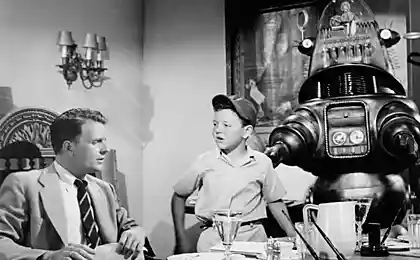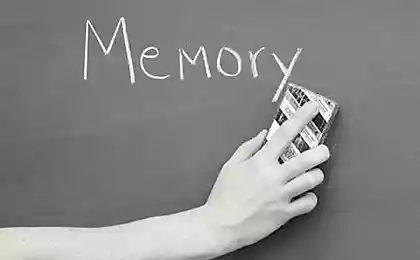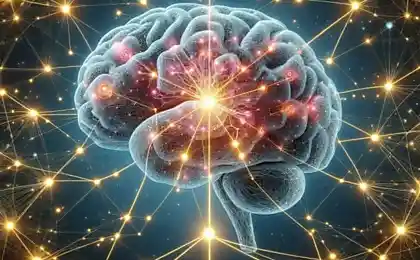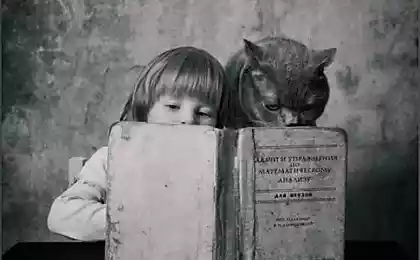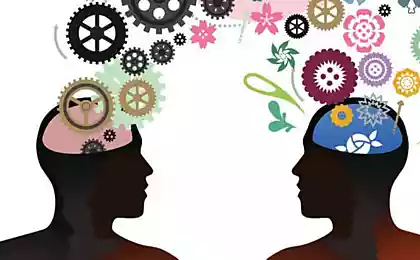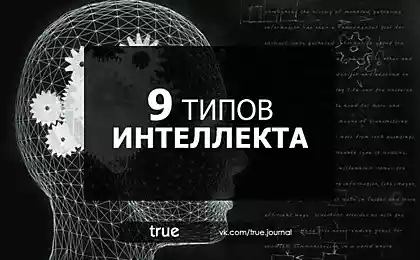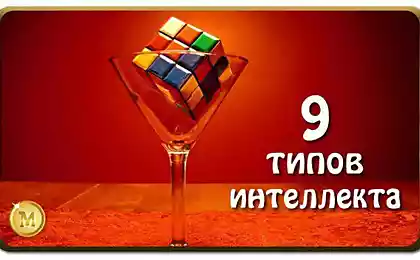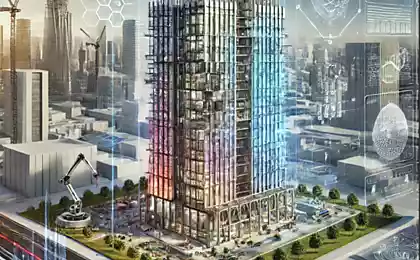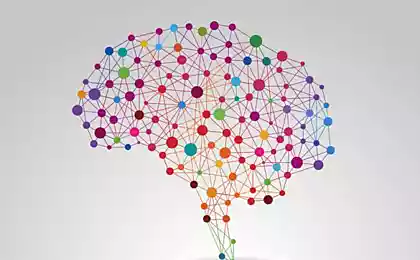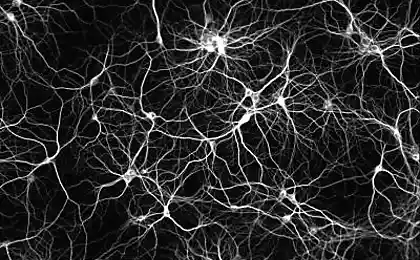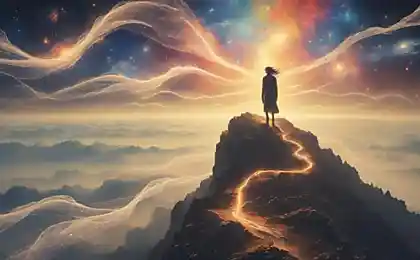2158
Logic thinking. Part 13. Associative Memory

This series of articles describes the wave model of the brain, is very different from traditional models. It is highly recommended for those who just joined, start reading from the first part of the .
In the previous section we have shown might look like shared memory. The basic idea is that the total wave identifier can combine neurons that form its activity memorable picture. To play a specific event is enough to run in the cortex corresponding identifier memories. Its distribution will restore the same pattern of activity that has been on the bark at the time of fixation of memories. But the big question - is how do we get the required ID? Associative memory implies that feature set, we can select events in the description which was attended by these signs. That is, there must be a neural mechanism that allows for the description of certain signs, get the ID matches the features of these memories.
When we talked about the propagation neural waves, we assumed that the neuron membrane keeps on extrasynaptic those wave pattern, which it is party. Faced with the familiar picture of neuron spike creates its unique continuation pattern. And here it is important that the neuron is not just able to learn the wave picture, and that he himself - often spread pattern. Just being himself part of a unique wave neuron can participate in its dissemination.
To avoid confusion in the following discussion, once again the basic properties of the wave model of the cortex. If you check the neurons belonging to the same wave pattern, or - in other words - the identifier, you get something like a set of points shown in the figure below.

Taking any place crust and activating elements of identity, we obtain the wave propagating from the active site, repetitive characteristic of the identifier pattern (shown below).

Passing through each place cortex wave will "highlight" a fragment of its unique design. So, starting from 1, the wave reaching the area 2, there will your unique identifier of a predetermined pattern (see Figure below).

According unique pattern can be in every place cortex to determine which identifiers comprise a wave.
If we are in a quiet area in the cortex of 2 reproduce the already familiar pattern, it will also create a wave that, spreading to the region 1, there will still the same pattern, characteristic for this identifier.
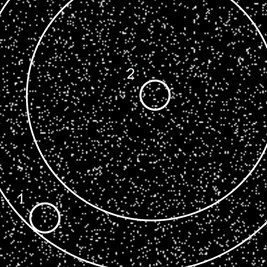
From all this it follows that for sufficiently recognition identifier anywhere bark remember what pattern in this place creates a wave. It can be stored at the synapse or a neuron, or a portion extrasynaptic membranes. Remembering to synapses leads to induced activity (pulse packet) for recognition, memorization on metabotropic receptive clusters produces single spikes when a familiar wave.
Difficult when we have to play identifier. To do this, we need to activate the at least single group of closely spaced spikes of neurons related to the required ID. Describing the reverse projection and introducing several mediators, we just show the mechanism of implementing something similar.
Speaking of associative concepts, we have shown that the query built on waves of identifiers, returns a set of identifiers of concepts associated with a concepts contained in the request.
To show the mechanism to retrieve memories of the associative memory of event we need to show how the wave request, consisting of concepts, attributes can give unique identifiers gippokampovskie memories that correspond to the request. If we can get a set of identifiers and to select one of them, then running this identifier back to the cortex, we obtain the activity of neurons-detectors containing this identifier to extrasynaptic membrane, and this would be tantamount to the restoration of the entire narrative paintings desired memories.
Let me remind you about our simplified and schematic description. Next, I will present a possible neural mechanisms of associative memory, while not claiming that the brain works that way.
Again briefly turn to the structure of real neurons. The body of the neuron - Catfish - has a limited area and can not provide a place for all of synaptic contacts. Most of the synapses falls on a branched structure, called dendrites or dendritic tree (picture below). The number of synapses, which are located on the dendrite, 10-20 times higher than the number of synapses on the soma.
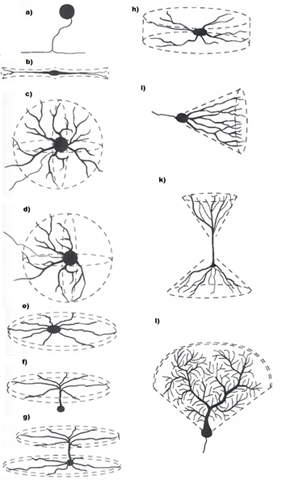
The forms of the dendritic trees (Greg Stuart, Nelson Spruston, Michael Häusser) i>
It has been found that a neuron behaves differently depending on whether the signals arrive at the synapses on one or different dendritic branches (Shepherd GM, Brayton RK, Miller JP, Segev I., Rinzel J., Rall W., 1985 ). Simultaneous arrival of the pulses at the synapses of one branch is significantly stronger response of the neuron than the signal distributed to different branches.
On the basis of observations of this kind was born the hypothesis that dendritic branches can play the role of coincidence detector (Softky, 1994). Its essence is that the signals produced in the distant branches of the dendritic tree, to generate a spike neuron need to be active segments of the dendritic tree, lying on the road signal to the soma.
This effect has been shown to pyramidal neurons (Jarsky T., Alex Roxin A., Kath WL, Spruston N., 2005), but it is believed that something like that is peculiar to neurons and other types.

The phases of signal propagation in the apical segments and inclined pyramidal neurons of the hippocampus. Signal occurs in the apical beam (red dot) and extends to the Schaffer collaterals (green dot). Signal in closer to the soma place dendrite does not allow the distant signal fade away and contributes to the spike (Jarsky T., Alex Roxin A., Kath WL, Spruston N., 2005) i>
Pulse propagation along the dendrites is accompanied by its significant attenuation. In theory, the effect of more distant (distal) synapses must be much smaller than the influence of close (proximal). However, mechanisms have been shown lining the contribution of such synapses, which resulted in the concept of "democracy synapses» (Clifton C. Rumsey, LF Abbott, 2006). Alignment contribution synapses along the branches of the dendrite branches can be considered as independent logic elements, whose signals are somehow further processed neuron. This means that, in theory, by changing the configuration of the dendrite and the reaction soma neurons can be obtained with different logical properties.
For example, in the popular concept of "hierarchical temporal memory" Jeff Hawkins applied neurons using autonomous elements operating mode "or" (shown below).
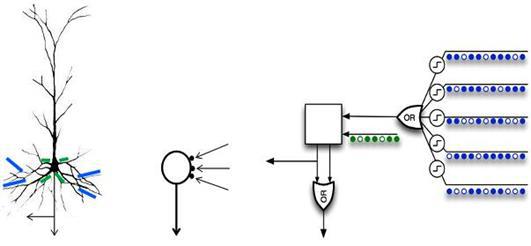
The model neuron with a set of logical dendritic autonomous elements in comparison with pyramidal neurons (Hawkins, 2011) i>
It is appropriate to assume that the real brain neurons operates with a substantial variety of properties.
Now let's move, actually, to the description of the associative memory of the event. Suppose that we have two types of neurons, forming a flat crust. Receptive fields of neurons cover some local area of your environment, where both types of neurons fall. Conditionally blew them into two layers, bearing in mind the cross-distribution relationships.
We define the neurons of the first type such that they wave propagates information identifier. Neurons of the second type will force applies solely wave identifiers hippocampus (figure below).

The spread of two independent waves on neurons with different types of mediator i>
To do this, dissolve their axons and extrasynaptic receptors used by mediators (table below). Note that to set the wave propagation of synaptic receptors are not important. Synapses th> Out of synapses th> Axon th> < Type 1 A A Type 2 B td > B Neurotransmitter characteristics of neurons. The sensitivity of the receptors and the release of the axon i>
With this setting, receptors and mediators wave two layers will not influence each other.
Now complicate the neurons of the second type, make their dendritic trees consisting of two types of branches, differing extrasynaptic mediators. When modeling homogeneous branches can be combined and the resulting leave two dendritic segment, operating on the principle "or" (table below). segment th> Synapses th> Outside synapses th> Axon th> Type 1 A A Type 2 1 B B 2 td > A Neurotransmitter characteristics of neurons. The sensitivity of the receptors and the release of the axon. Neurons of the second type have two dendritic segment with receptors sensitive to various types of neurotransmitters i>
Suppose that while there was a trained neural Just as the wave propagates identifiers in neurons of the second type was blocked by the second segment, which is sensitive to the "alien" mediator. All information required for the formation of waves in neurons of the second type will be deposited into extrasynaptic memory of the first segment.
Now, if we include the second segment, then they will begin memorizing wave patterns propagating along the neurons of the first type. We assume that extrasynaptic memorization comes at a time when the neuron generates a spike. In this case, no fixed snapshot of activity at the synapses, and accumulated over the entire cycle of propagation. Accumulation will allow us to remember the first wave fragment level, even if the phases of the waves of two levels in a place of remembering not match. That is, when the second level will give neuron spike, it will lock the picture information activity, even if it was some time ago.
Suppose we had a single cycle of the memorization. All neurons of the second level, the propagating wave identifier hippocampal activity in this cycle, remember to their second segment fragments of information wave transmitted by the neurons of the first type. This means that if we ever repeat the same wave description, all the neurons of the second level, which recognize this picture, will spike. The overall picture of these spikes will reproduce the same identifier of the hippocampus, which was at the time of storing this information image.
So it is possible to store a variety of descriptive pictures. By repeating the respective descriptions of neurons of the second level will give the total combination of all identifiers of the hippocampus that fall under the current description.
It is evident that such storage is extremely wasteful. We remember every image on the active neurons of the second type. While playing for the ID we need just a small local area, how to start a wave. To remedy the situation, we will remember not the wave information on all active neurons of the second type, but only to those who fall in the high-evoked activity of neurons of the first type. That is, let us recall that the information is dualistic. It is both identificatory wave, and activity patterns evoked activity. Give us a wave pattern to memorize and patterns indicate the place for this.
The easiest way to choose one's place - is to use the same field of activity, which we used for the spatial patterns of self-organization. In such a configuration can be represented as storage. In areas of the cortex, where information picture creates patterns evoked activity, formed field of activity. All active neurons of the second type, the propagating wave hippocampus, for which the field of activity above a certain threshold, fixed at extrasynaptic memory pattern described by a wave of information.
Submitting information wave request, we obtain the activity of neurons of the second type, learned this request. Local groups such neurons of the hippocampus will radiate identifiers relating to all the memories associated with that request.
We have shown how can be fixed and unique identifiers to recover memories. Previously, we have shown that if neurons-detectors keep the memory of such a unique ID that you can recover images corresponding to the stored points. The table below shows a possible configuration of mediators for such a memory. segment th> Synapses th> Out of synapses th> Axon th> Type 1 1 A A 2 B Type 2 1 B B < / 2 A Neurotransmitter characteristics of neurons. The sensitivity of the receptors and the release of the axon. Doubly-connected configuration i>
Setting the storage region through the field of activity - fairly blunt instrument. There are some obvious ways to improve the design. For example, it is possible through learning synaptic neurons of the second type to create from these areas corresponding to the concepts located in the place of the cortex. Using the concept of dendritic coincidence detector, can be done so that the activity of the concept will be essential, both for recording and for generating feedback identifiers memories associated with this concept.
In general, the wealth of tools that provides a wave model of the crust with multisection neurons allows to realize quite complex and interesting design. Limited until already given the simplest schemes, in order not to confuse the narrative.
References
Continued
Previous parts:
Part 1. Neuron
Part 2. Factors
Part 3: Perceptron, convolutional network
Part 4. Background activity
Part 5. The brain waves
Part 6. System projections
Part 7: Human-Computer Interface
Part 8: Allocation of factors in the wave networks
Part 9 patterns of neural detectors. Rear projection
Part 10: Spatial self-organization
Part 11. Dynamic neural networks. Associativity
Part 12. Traces of Memory
Alex Redozubov (2014)
Source: habrahabr.ru/post/216301/


